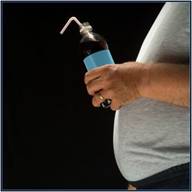| |
|
Fattening Fructose by Jean Jitomir
FATTENING Fructose! How Processed Sugars Can Maximize Your Middle…

Fructose is the new trans fat.
Everyone hates fructose; it is en vogue to use the simple sugar as a scapegoat for America's obesity problem, but is there anything to this fructose blasting trend?
What Kind of Carbs? Where Do They Go?
Let's start with a very simple review of how carbohydrates are used in the body. First you eat--or drink-- something that is high in carbohydrates. The source could be "complex," like oats, whole grain pasta, quinoa, beans, potatoes, or even fibrous vegetables, like broccoli. The usable carbohydrates from these sources will eventually be broken down in the digestive tract and absorbed as the simple sugar glucose.
Table sugar, other processed sugar and syrups, and some natural foods usually contain a combination of "simple" sugars. For instance, milk contains the sugar lactose, which breaks down into the simple sugars glucose and galactose. Table sugar is sucrose; this sugar breaks down into glucose and fructose (50/50). Sources like fruit and high fructose corn syrup also provide glucose and fructose, but fructose is slightly favored (about 55/45, give or take). In the media, there has been a demonizing of high fructose corn syrup (HFCS), specifically.
After you eat carbohydrates and they are absorbed as simple sugars (one unit carbohydrate molecules), they are all sent to the liver first, and the liver can decide their fates. In the case of glucose, the liver can a very orderly and controlled process and can do several things based on the body's needs. If you've just come back from a really long run, your liver may decide to replace depleted carbohydrate storage in the liver, glycogen. If your liver is doing a lot of processing and needs energy for itself, the glucose may be used simply to make more energy units. If you haven't eaten for 12 hours, your liver may recognize that your blood sugar is low and then send all of the glucose in to the blood. On the other hand, if you've been sitting and eating all day and you have lots of energy in your body, the liver will recognize that energy surplus and change the glucose into fat for long-term storage.
Fructose is also sent straight to the liver, but it is dealt with in a more chaotic fashion once it gets there. Because it has a different structure than glucose, the easiest thing for the liver to do with fructose is simply make fat. Scientists have speculated for a long time that the liver does this, but no one really proved it, until recently.
The Latest Fructose Research
Dr. Elizabeth Parks and her colleagues recently did a study where 6 people (4 men and 2 women) all went through three different experiments. One time, the participants drank a solution containing 100% glucose (85g of total carbohydrate; 340 Calories worth) while fasted in the morning. Another time they had 50% glucose and 50% fructose (this is a lot like drinking soda or another beverage with high fructose corn syrup). Finally, they were also fed 25% glucose and 75% fructose on another occasion. Additionally, the participants were fed a standard lunch with each experiment four hours after the "breakfast" sugar drink.
The researchers actually showed at the end of the experiment that both of the higher fructose solutions resulted in significantly higher fat production in the body than the pure glucose solution did immediately after drinking the beverage. The high fructose drinks also cause a greater storage of fat from the standard lunch meal. WOW! The same calories, all carbohydrates, but the fructose made more fat in the body!
Other Recent Fructose Research
After reading a popular story on the research above and the original research paper, I decided to do a search of the recent fructose research. A recent article in the Current Opinion in Lipidology showed that high-fructose, but not high-glucose, diet increased circulating fat after eating.
In another study overweight post-menopausal women were given diets to maintain their weights. Thereafter, the women were given diet with the same number of Calories, but with 25% of the Calories coming from high-fructose beverages. The women's circulating fat 14 hours after eating was 141% higher after the fructose beverages were included in the diet. And many more research papers can be found.
Sports Nutrition Application
In the first study, where the three different sugar drinks were given, the participants had they drink in a fasted state, in the morning. That means two things 1) liver glycogen was probably low because the carbohydrate reserve was used to maintain blood sugar throughout the night 2) general energy state in the body was low; yet, a high fructose drink still caused the increased fat production. This means that the carbohydrates were NOT being used to replace lost glycogen stores after a fast.
Athletes fatigue during endurance events when glycogen stores wane. If your fuel/carbohydrate sources of choice is not metabolically primed to make glycogen, it may be time to consider another source of carbohydrates for optimal performance. This is, of course, pure speculation. But you cannot go wrong by carbing up with a source that will definitely come into your liver as glucose, namely, the "complex" sources listed above. Note that Gatorade has sucrose syrup (50% fructose) and glucose-fructose syrup (unknown amount of fructose) as the carb-providing ingredients. Honey is a good source of glucose. A carb drink can easily be made at home with water, honey, lemon and a little salt.
Health Implications
After perusing some of the recent research regarding fructose, I am fully convinced that processed, added fructose is detrimental to health, and I will AVOID it in the future. Remember that table sugar enters the body as 50% fructose; this is not so far off from the 55% fructose of HFCS. Most processed, added sugars are likely to be high in fructose even if the ingredients label does not have fructose listed anywhere on it.
Tricky Product Reformulation
Since HFCS has received a lot of terrible press, many manufacturers are reformulating products to omit that specific term from the packaging; however, the products are often not actually lower in fructose. A perfect example of this trick is the new balance bar reformulation.
High fructose corn syrup used to be one of the first ingredients listed on the package of the Balance Yogurt Honey Peanut bar; however, now the outside of the box boasts "No high-fructose corn syrup." At the same time, the newly formulated bar reads 1) a protein source; 2) corn syrup; then; 3) fructose. Based on the ingredients, the amount of fructose that is delivered to your trusty little liver would still be about the same as the HFCS products or, potentially, higher. Given the opportunity to reformulate a health product, wouldn't it be better to make it healthier? WHAT'S UP WITH THAT?

The Point
The "bad stuff" in the food supply has one major thing in common-- excessive processing! Build a diet based on real food, that does not come from a shelf-stable package, and you will automatically avoid trans fats, high sodium and excessive fructose.
What about fruit?
Fruit is a natural and healthy source of food--it should not be omitted from the diet to avoid fructose! For instance, fruit has a variety of redeeming qualities, like an abundance of antioxidants and fiber, which certainly make it worth eating! Furthermore, fructose portion must be kept in perspective. A nectarine has 60 Calories and about 13g of sugar; about 7g are fructose. A regular 20oz soda has 240 Calories; 67g carbohydrates; about 37g of fructose. Essentially, you would have to eat 5 nectarines to get the same about fructose as one bottle of coke. After 5 nectarines, you'd be really full and loaded with over a gram of potassium and 12g of fiber. After drinking one bottle of coke, you'd still be up for a pizza, so choose wisely ;-)
Back to
Issues
|
About the Author...

Jean Jitomir is a registered dietitian, Master of Science in Nutrition and is currently working on her Ph.D. in Exercise Nutrition at Baylor University. She has experience as a private dietitian and cooking instructor. Jean has competed in figure at the national level and is qualified for national level competition as a light weight bodybuilder.
jeanjitomir@yahoo.com |
|
|





